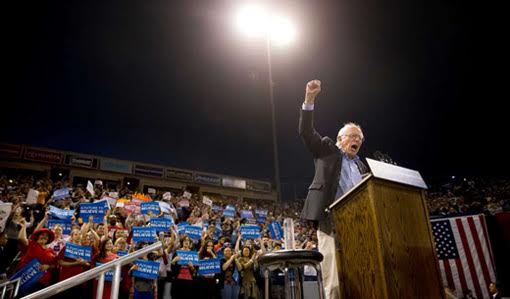
One fact has forcefully emerged from the results of recent balloting in primaries across the country: to prevent the right wing from capturing the White House in November, Democrats will need a campaign based on more than exposing the dangers posed by Donald Trump. They will need solid unity behind a program that can prevent the defection of traditionally Democratic voters, particularly white working class voters.
National and state polls aimed at predicting the outcome of the presidential election in November are showing Trump neck and neck with Hillary Clinton. In fact, he beats her in some states. The reason: many working class voters are switching to Trump because their standard of living has plummeted, they feel ignored by the U.S. government, and they feel powerless to improve their own conditions.
They feel a “strong man” like Trump could do what they cannot: protect them from an insecure future.
On the other hand, Bernie Sanders has won the votes of white working class folks in all recent primary elections, including those held last week in Indiana and West Virginia and last night in Kentucky. He won the Indiana and West Virginia primaries outright and almost tied Clinton in Kentucky.
In West Virginia, although some Sanders voters said they would support Trump in November, more said they voted for Sanders because they want federal policies and programs that are “more liberal” than those put in place by President Obama.
Moreover, last night Sanders won the primary in the state of Oregon, largely because of the support of voters under 45 years old in all demographic groups.
The primary was the first election in which Oregon’s new “motor voter” mail-in system was used. Under the new law, anybody applying for a driver’s license was automatically registered to vote. Then, they had several weeks prior to yesterday to mail in their ballots or drop them off at voting sites.
Over 51,000 voters were added to the rolls.
Despite his recent wins, however, what pundits call the “delegate math” does not add up for Sanders. To date, he has won 1,473 delegates, including 41 super delegates while Clinton has the support of 2,240 delegates (including 524 super delegates), which puts her within touching distance of the 2,383 needed to secure the nomination.
Short of something unforeseen, it is inevitable that Clinton will go to the Democratic National Convention in July with the nomination sewed up.
That’s why, to insure a victory over Trump, it’s becoming more urgent that her campaign be ready to inherit the grassroots organizational models and far reaching proposals that have attracted so many working people and millennials to Bernie Sanders’ political revolution. It has also become urgent that the Sanders campaign be ready to unite with the Clinton effort.
It is inevitable that this will happen.
However, in recent days the civility that has marked the relationship between the Sanders and Clinton campaigns has been damaged and efforts at building unity have been sidetracked.
In Las Vegas, the state Democratic Party convention fell into chaos after nearly 60 of Sanders’s potential delegates were deemed ineligible by the Nevada State Democratic Chairperson Roberta Lange. Security guards shut the meeting down after participants began to yell and throw chairs around.
Lange later said Sanders supporters had put her address and phone number online and that she had received “death threats” by phone.
Although there was no way to verify that the threats had come from his supporters, Sanders quickly said that violence had no place in his campaign.
Both he and Clinton called for their supporters to get back to addressing the issues facing the U.S. and to focus on building a movement to defeat Trump.
Both the Clinton and Sanders campaigns are taking measures to woo working people back into the Democratic Party fold.
Clinton and her husband spent many days in Kentucky campaigning among workers in coal country even though she long ago conceded this area would vote for Sanders in the primary election. The Clintons’ goal was to build support among these workers for the Democratic Party in the general election.
Furthermore, according to Abby Phillip writing in the Washington Post, Clinton is dispatching staff to Pennsylvania, Wisconsin and Michigan whose primary goal will be to woo white workers who might be thinking of voting for Trump.
“Clinton performed poorly against Sen. Bernie Sanders [among white workers] in Democratic primaries in this part of the country,” Phillip wrote, “partly because of her past support for free trade agreements and partly because Sanders’ promises to focus on economic issues and income inequality resonated with voters.”
Phillip wrote that “Joel Benenson, Clinton’s chief pollster and senior strategist acknowledged that Trump’s popularity, particularly among white working-class voters, could make states in the country’s industrial midsection more competitive than they have been in recent elections.”
Meanwhile, in his speech in California last night, Sanders said “I come from the working class of this country; I’ll be damned if I will allow the Republican Party to win votes of working class Americans.”
He called on the Democratic Party to “open its doors” and to work to once again win the support of working people.
In appealing to working people, Sanders emphasizes, among other things, the need for a raise in the minimum wage and for universal health care. He also promotes the need for union rights and collective bargaining. He presents plans to create jobs by rebuilding the nation’s deteriorating infrastructure and programs to guarantee aid and employment to workers displaced by the nation switching from fossil fuels to sustainable energy.
Clinton emphasizes what observers call the “politics of inclusion.” She says that all people should have opportunities to “rise.”
What is needed, and needed now, is for Sanders and Clinton to merge their goals and design dynamic programs that address the economic crisis facing millions of American workers.
Furthermore, they need to build on the foundation of the “political revolution” growing out of the Sanders’ campaign. This foundation has laid the groundwork for a movement that will encourage working people to work together for economic justice.
If encouraged to grow, this movement will give working people a realistic hope for a better future.
Such a movement could become an effective answer to the lure of authoritarians like Donald Trump who say to American workers “leave it to me” and who will ultimately steer our economy and our government toward serving only the top one percent.
Photo: At his speech in Califoprnia Tuesday night, Sanders said, “I come from the working class of this country and I’ll be damned if I allow the Republican Party to win votes of workingclass Americans.” | Jae C. Hong/AP.










